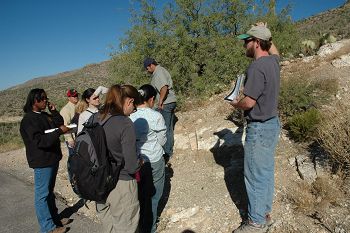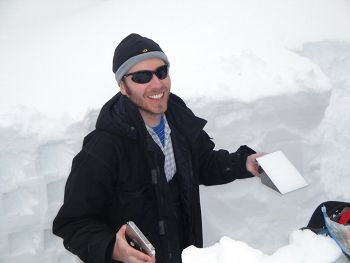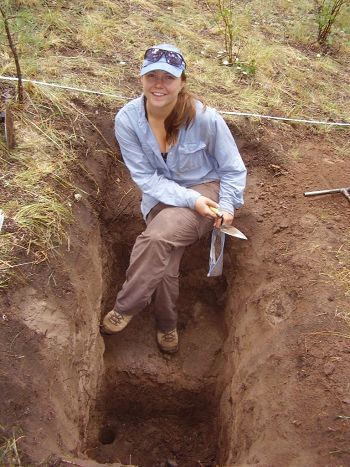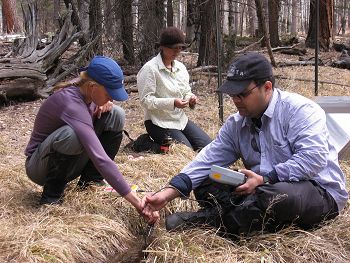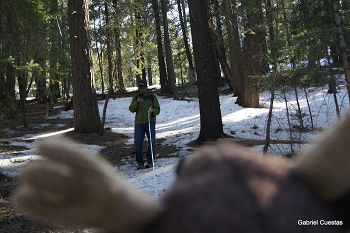Higher Education
Snow hydrology class with snow survey in 2012.
Critical Zone science now permeates curricula developed within several departments at the University of Arizona including Soil, Water and Environmental Science, Geosciences, Hydrology and Water Resources, and the School of Natural Resources. Examples of several courses that use the CZO sites as field-based laboratories are given below.
Critical Zone Science & Management
This new course will serve as a comprehensive introduction to the latest advances and ideas of Critical Zone Science. The University of Arizona version of this course will be led by Dr. Jim Washburne. This course is part of a team development effort spread across five CZO’s and is part of SERC’s Interdisciplinary Teaching about Earth for a Sustainable Future (InTeGrate) Series. Science students from all CZO disciplines can benefit from the course’s systematic presentation of key CZ topics (including: CZO Background, Methods in CZ Science, Land-atmosphere Exchange, Water Transfers through the CZ, Landform & Landscape evolution, Geochem & Biogeochem, and Humans in the Critical Zone). An outline of the Land-atmosphere Exchange module can be found at: http://web.sahra.arizona.edu/hwr203/czo.
Pedology Course
The SWES upper division and graduate class Soil Genesis, Morphology and Classification, taught by investigator C. Rasmussen, takes field trips observe soils across the Santa Catalina Mountain environmental gradient. The field trips highlight the importance of climate, parent material, vegetation, and aspect in controlling soil formation and soil forming processes. These trips tie directly to CZO related research and results from CZO research are incorporated into the curriculum for this course.
Snow Hydrology Course
The Snow Hydrology Course, led by Prof. Paul Brooks, includes an annual Spring Break field trip to the Jemez River Basin CZO that normally coincides with near maximal snowpack and SWE. Students in the class learn techniques of snow survey including depth dependent measurements of snow water equivalent, that provides a basis for long term CZO data acquisition and analysis and results are summarized in the paper:
Harpold, A.A., P.D. Brooks, S. Rajagopal, I. Heiduechel, A. Jardine, and C. Stielstra. (In Review). Changes in Snowpack Accumulation and Ablation in the Intermountain West. Water Resources Research.
Geomorphology Field Course
The graduate-level geomorphology field and modeling course, taught by Prof. Jon Pelletier, includes field-based measurements in the Jemez River Basin and Santa Catalina Mountains CZO sites. A recent set of studies involved collaborative, class-wide, calibration and testing of upland hillslope evolution models and resulted in the paper:
Pelletier, J.D., L.A. McGuire, J. L. Ash, T. M. Engelder, L. E. Hill, K. W. Leroy, C. A. Orem, W. S. Rosenthal, M. A. Trees, C. Rasumussen, and J. Chorover. 2011. Calibration and testing of upland hillslope evolution models in a dated landscape: Banco Bonito, New Mexico. J. Geophys. Res. - Earth Surface 116, F04004, doi: 10.1029/2011JF001976.
Advanced Topics in Hydro-Bio-Geochemistry Interactions
Students in this team taught (3 CZO PIs) seminar course spend several days over Spring Break in the Jemez River Basin CZO site collecting and analyzing snow and surface water samples to investigate hydrologic and biogeochemical processes in seasonally snow-covered catchments. This work ties into CZO cross-theme efforts in subsurface biogeochemistry, surface water dynamics, and ecohydrologic partitioning.
Brooks, P.D., P.A. Troch, M. Durcik, E. Gallo, and M. Schlegel (2011) Quantifying regional-scale ecosystem response to changes in precipitation: Not all rain is created equal, Water Resources Research, Water Resources Research, 47, W00J08, doi:10.1029/2010WR009762
Field Hydrology Course
The University of Arizona's Field Hydrology course, led by Prof. Tom Meixner (HWR), has used the Biosphere 2 tower site on Mount Bigelow for its annual snow field course exercise. This exercise ties into CZO related work on snow-vegetation interactions. Additionally the field course measures streamflow and chemical/isotopic composition of water in Sabino Creek at the USGS stream gauge for Sabino Creek. The students focus on understanding storm influences on streamflow and on chemical composition.
Craig is discussing soil forming processes in desert scrub ecosystem. Photo: Emiko Ariyasu
It is always fun to take field hydrology class. Ingo during 2010 snow survey.
Caitlin in a soil pit . Photo: Jon Pelletier
Clare, Bhaskar and Zulia sampling stream water field parameters. Photo: Jen McIntosh
Measuring snow field. Photo: Gabriel Cuestas
Critical zone illustration.
News
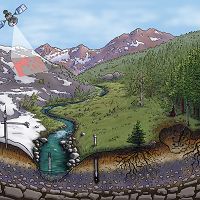
Undergraduate course curriculum, “Introduction to Critical Zone Science,” available free online
01 Jan 2018 - A 15-week semester-long upper-level undergraduate course curriculum entitled “Introduction to Critical Zone Science” is now available free online.
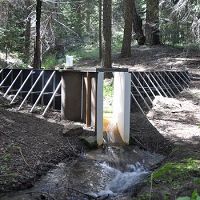
Water Resources Research Special Collection: Concentration-discharge relations in the critical zone
30 Oct 2017 - Water Resources Research published a new special collection in September 2017 featuring concentration-discharge research from multiple CZOs.
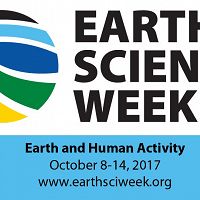
Earth Science Week 2017 Video Contest
15 Aug 2017 - For Earth Science Week 2017, the American Geosciences Institute invites you to enter the Earth Connections video contest. Submit a brief, 30-90...

2017 CZO Webinar Series: Critical Zone and Society
06 Apr 2017 - 2017 CZO Webinar Series: Critical Zone and Society.
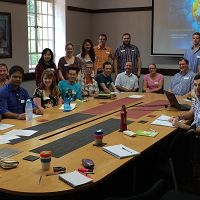
Video: CZ graduate students reflect on experience at University of Western Australia Summer School
13 May 2015 - Students from around the Worldwide Universities Network (WUN) gathered in Perth for two weeks in Feb. 2015 for the Inaugural WUN Summer School.
Explore Further


